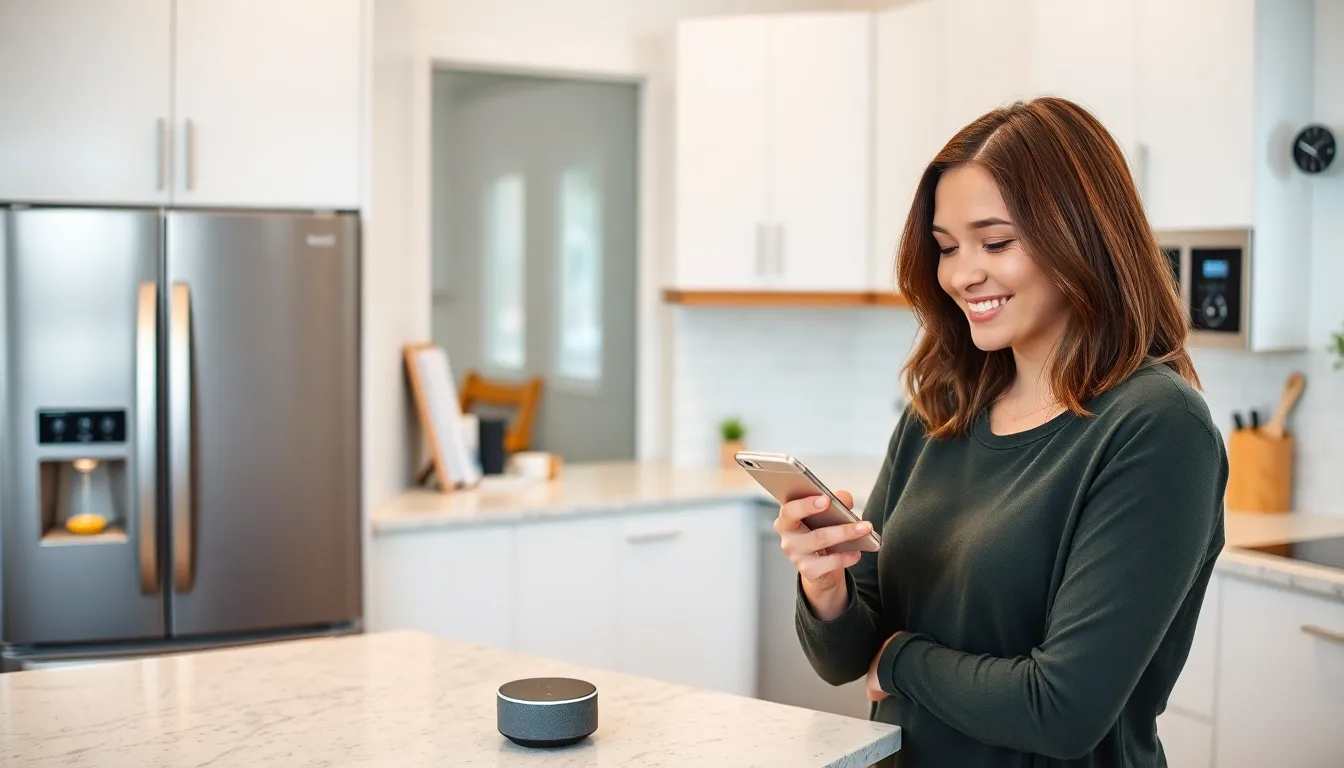In a world where your coffee maker might soon know your caffeine cravings better than your best friend, smart living is no longer a futuristic fantasy—it’s the new normal. Imagine waking up to the soothing sounds of your favorite playlist while your thermostat adjusts to the perfect temperature. With technology weaving itself into every corner of life, it’s time to embrace the gadgets that make everyday tasks feel like a walk in the park—or at least a stroll down a very tech-savvy street.
Table of Contents
ToggleOverview of Smart Living and Technology
Smart living integrates technology into everyday life, enhancing convenience and efficiency. Devices such as smart speakers, smart lights, and home security systems connect users, creating an ecosystem that streamlines household management. Each device communicates over the internet, allowing for remote control and automation of various tasks.
Data shows that 72% of consumers prefer smart devices for energy savings and improved security. Smart thermostats adjust temperatures based on user patterns, which can decrease energy bills while increasing comfort. Smart appliances like refrigerators track inventory, suggesting recipes and reducing food waste.
Home automation plays a crucial role in creating a seamless living environment. Users can program routines, ensuring lights turn on at preferred times, or that the coffee maker brews at a scheduled hour. Integration with smartphone apps lets individuals control their homes from anywhere, adding an extra layer of convenience.
Voice assistants, such as Amazon Alexa or Google Assistant, allow for hands-free operation of smart devices. Users can command their devices to play music, set reminders, or control temperature with simple voice prompts. This accessibility appeals to various demographics, including those seeking ease of use.
Continued advances in artificial intelligence contribute to the growth of smart living. As these technologies evolve, devices become more intuitive, learning user preferences and enhancing the overall experience. Smart living not only simplifies daily tasks but also creates a more personalized lifestyle.
Technological innovations are reshaping how people interact with their environments, providing solutions that cater to modern needs. With an increasing array of smart devices available, embracing this change enhances day-to-day living.
Key Technologies Driving Smart Living

Smart living thrives on innovative technologies that seamlessly integrate into daily routines. Two key players in this transformation are the Internet of Things (IoT) and Artificial Intelligence (AI).
Internet of Things (IoT)
IoT encompasses interconnected devices that communicate with each other to enhance convenience and efficiency. Smart appliances, such as refrigerators and ovens, provide real-time data on inventory and usage patterns. Users consistently favor smart thermostats, as research shows that 72% of consumers appreciate energy savings. Connectivity allows for remote monitoring, enabling homeowners to adjust settings on the go. Smart security systems enhance safety by sending alerts about unusual activity. Utilizing sensors, IoT devices automate regular tasks, freeing users from manual control and improving their overall quality of life.
Artificial Intelligence (AI)
AI, a major driver in smart living, makes devices more intuitive and responsive. Voice assistants learn user preferences, making interactions smoother and more personalized. By analyzing data, AI optimizes functionality; smart thermostats adjust temperatures based on individual habits, promoting energy efficiency. Predictive algorithms anticipate needs, allowing for proactive management of home environments. Continuous advancements in AI technology promise even greater usability and smarter solutions, making everyday tasks less burdensome. Individuals increasingly rely on AI to enhance their living experiences, transforming traditional routines into effortless interactions.
Benefits of Smart Living
Smart living offers numerous advantages that enhance daily life through technology. Integration of smart devices allows for a more efficient and convenient environment.
Enhanced Convenience
Smart living significantly boosts convenience. Tasks like adjusting lighting or setting home temperatures can occur with just a voice command. Smart speakers enable users to control multiple devices hands-free. Automating routine tasks becomes simple; for instance, smart coffee makers prepare the brew ahead of time. Such advancements transform mundane chores into more enjoyable experiences. Additionally, smartphone apps provide the ability to manage household functions while away, ensuring peace of mind and control.
Improved Efficiency
Efficiency in daily tasks benefits greatly from smart living technology. For instance, smart thermostats adjust to user preferences, saving energy and reducing bills. Data indicates that 72% of consumers favor smart devices for these energy savings. Inventory tracking through smart appliances helps minimize food waste, optimizing consumption. Home security systems enhance safety by providing real-time alerts about unusual activity. Users experience a notable shift in how they interact with their environments, creating a more streamlined lifestyle.
Challenges and Concerns
Smart living and technology present numerous benefits but also raise challenges and concerns. Users must navigate issues related to privacy and dependence on technology.
Privacy Issues
Privacy concerns top the list of challenges in smart living environments. Data collection from devices occurs constantly, creating potential risks of unauthorized access. According to recent statistics, 60% of consumers express worries about how companies handle personal information. As smart devices collect data on routines and preferences, users face increased exposure to data breaches. Many smart home products lack robust security measures, allowing hackers to exploit vulnerabilities. Continued vigilance around data privacy is essential for users to mitigate these risks effectively.
Dependence on Technology
Dependence on technology presents another significant challenge. Users often rely heavily on smart devices for everyday tasks. Studies indicate that 58% of consumers feel uneasy when they cannot access their smart technologies. Over-reliance may lead to diminished problem-solving skills and reduced self-sufficiency. As devices handle tasks like managing schedules or controlling home environments, individuals might struggle to function without them. Maintaining a balance between utilizing technology and fostering personal capabilities is essential for ensuring long-term independence.
Future Trends in Smart Living and Technology
Smart living continuously evolves as emerging technologies reshape everyday experiences. Integration of 5G technology offers faster, more reliable connectivity for smart devices, enhancing functionality and communication. Increased bandwidth allows for seamless data transfer between devices, promoting real-time automation and efficiency.
Sustainability gains importance in smart living, as environmentally friendly solutions become prevalent. Smart home systems optimize energy use, leading to noticeable reductions in consumption and costs. Many homeowners now choose energy-efficient devices, contributing to lower utility bills while supporting eco-friendly practices.
Health and wellness technology also play a pivotal role in future smart living. Wearable devices monitor vital signs, promoting healthier lifestyles. Integration with home systems can enhance wellness by adjusting indoor environments based on user health data and preferences.
Interoperability of devices stands out as a crucial focus. Compatibility between various smart products allows for unified control systems. Consumers expect versatile platforms, leading to innovations that enhance user experience and convenience.
Privacy and security enhancements remain paramount, addressing growing concerns about data protection. Developers are prioritizing features that safeguard personal information while maintaining ease of use. Stronger encryption methods and transparent data policies are necessary to build consumer trust.
Home robotics also emerge as a transformative trend within smart living. Robots assist with tasks ranging from cleaning to lawn maintenance, freeing users from mundane chores. Emerging technologies in this area promise increased functionality, making daily life even more convenient.
Voice and gesture recognition technology continues to improve. More intuitive interactions will shape user experiences, allowing seamless control of smart devices. As advancements in artificial intelligence progress, smart devices will learn user preferences better, adapting to needs and optimizing performance.
Smart living is revolutionizing daily life through technology that enhances convenience and efficiency. As devices become more intuitive and interconnected, they transform mundane tasks into seamless experiences. The integration of IoT and AI not only streamlines home management but also fosters a lifestyle that prioritizes energy savings and security.
While the benefits are substantial, challenges such as privacy concerns and reliance on technology must be addressed. Striking a balance between embracing innovation and maintaining personal independence is crucial for users. As advancements continue to emerge, the future of smart living promises to redefine how individuals interact with their environments, paving the way for a more connected and efficient lifestyle.

